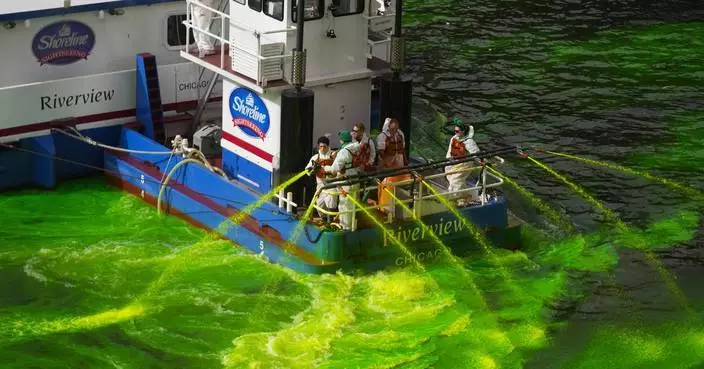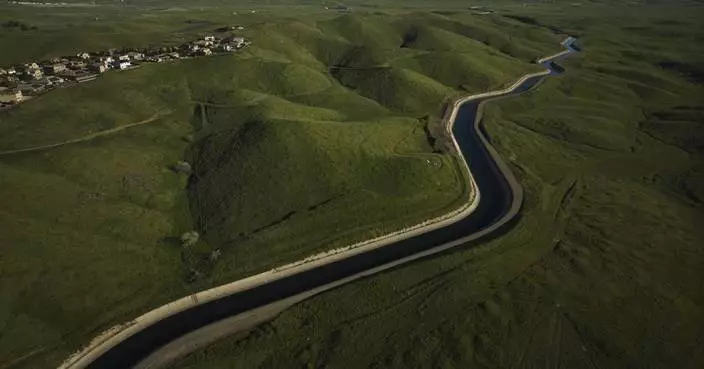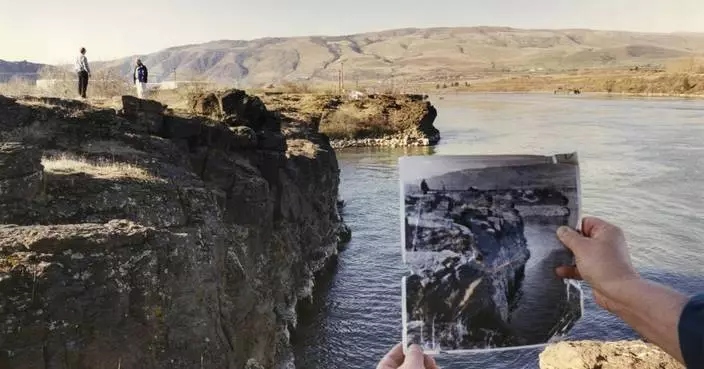The Qiantang River tidal bore is as famous as the ones on the Ganges in India and the Amazon in Brazil.
The river, originating in the border region of Anhui and Jiangxi provinces, runs for 459 kilometers through the coastal Zhejiang province, passing through the provincial capital Hangzhou before flowing into the East China Sea via the Hangzhou Bay.
Click to Gallery
The annual Qiantang River tidal bore, which is expected to be seen this year during the National Day holiday week, attracts tens of thousands of people from home and abroad. (Photo/China Daily)
Thousands of people gather on the bank of the Qiantang River last year to get a view of the annual tidal bore in Hangzhou, Zhejiang province. (Photo/China Daily)
The annual Qiantang River tidal bore, which is expected to be seen this year during the National Day holiday week, attracts tens of thousands of people from home and abroad. (Photo/China Daily)
The annual Qiantang River tidal bore, which is expected to be seen this year during the National Day holiday week, attracts tens of thousands of people from home and abroad. (Photo/China Daily)
The annual Qiantang River tidal bore, which is expected to be seen this year during the National Day holiday week, attracts tens of thousands of people from home and abroad. (Photo/China Daily)
The two tides then come closer and flow together like embracing lovers, offering a magnificent view. (Photo/China Daily)
The river is the southern terminus of the ancient Grand Canal that links five major rivers in China from north to south, and enables water-borne traffic to travel inland from Hangzhou as far north as Beijing.
While the Hangzhou Bay at the mouth of the Qiantang is about 100 km wide, the river narrows to a mere 2-3 km at one point-its Yanguan section. And as the tidal waters are blocked by the narrow river passage, pressure builds up from behind until a tidal bore is formed, creating a high water wall.
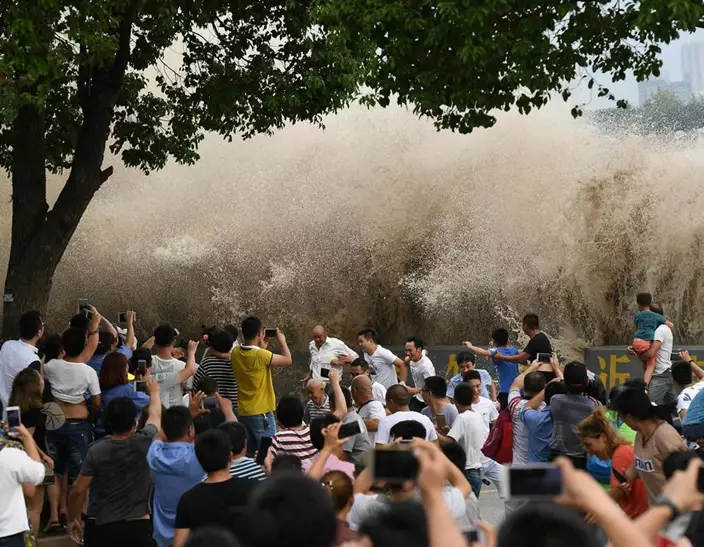
The annual Qiantang River tidal bore, which is expected to be seen this year during the National Day holiday week, attracts tens of thousands of people from home and abroad. (Photo/China Daily)
In addition, the presence of a submerged sandbar at the mouth of the river acts like a springboard for the tide, sending the crest of the bore higher.
Also, combined with the gravitational pull of the celestial bodies and the centrifugal force produced by the rotation of the Earth, tidal waves are created for the first five days and in the middle of every month according to the lunar calendar, which adds up to about 120 days a year.
Around the middle of the eighth month this year, based on the lunar calendar, the tidal force reached its peak, and the waves were as high as 5 meters, with a tidal range of up to 10 meters between the highest and the lowest points.
However, the most extraordinary sight can be expected from Oct 4 to 7 during the country's yearly National Day holiday week.
The Qiantang tide has been well documented since ancient times.
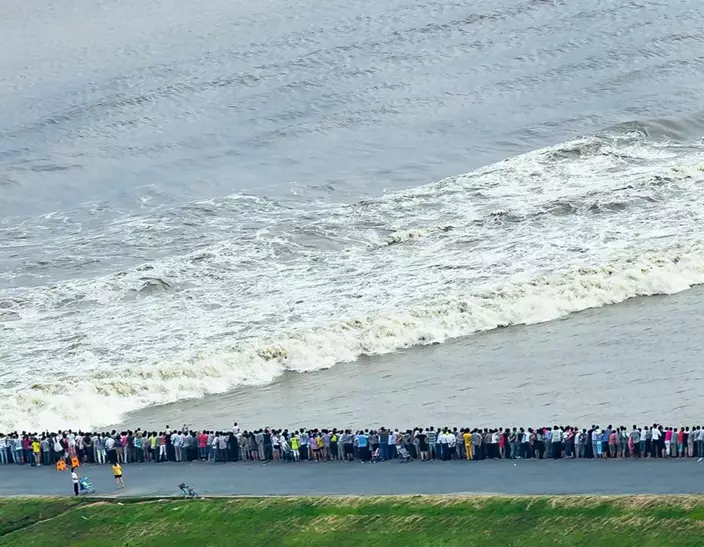
Thousands of people gather on the bank of the Qiantang River last year to get a view of the annual tidal bore in Hangzhou, Zhejiang province. (Photo/China Daily)
As early as the 4th century BC, China's famous philosopher Chuang Tzu (Zhuang Zi) described the huge tide as follows: "The waters in the Qiantang River will roll on, raising waves as high as mountains and towers, creating a thunderous roar and gathering up a force that threatens to engulf the sun and the sky."
A famous poet Su Dongpo in Northern Song Dynasty (960-1127) wrote:
"What on Earth can hope to create a spectacular sight,
Like the tides on the eighteenth of August at night."
Tide watching on the Qiantang has been a popular activity for centuries, dating back to the Han Dynasty (206BC-AD220).
It had also become a well-established event on the social calendar for both ordinary people and the royal court by the time of the Southern Song Dynasty (1127-1279).
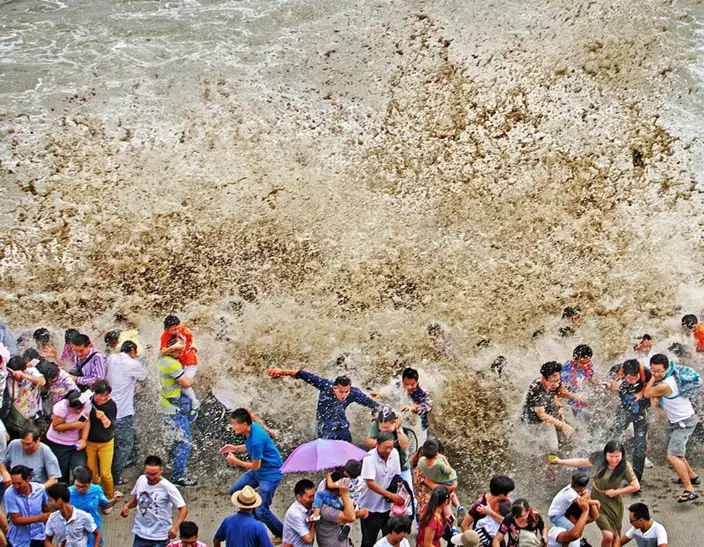
The annual Qiantang River tidal bore, which is expected to be seen this year during the National Day holiday week, attracts tens of thousands of people from home and abroad. (Photo/China Daily)
The Southern Song government even made it a rule to parade its naval forces in the Qiantang River on the 18th day of the eighth lunar month, an event that later developed into the present tide watching festival.
During the festival, expert swimmers line up to test their valor against the might of the tide each year.
There are historical records of men who would attempt to ride the waves of the tide on specially constructed boards.
Known in Chinese as nong chao er or "tide player", they are regarded as the first generation of Chinese surfers.
It is a tribute to their daring and skill that the words nong chao er have now come to mean people who are brave and courageous in the face of adversity.
In the Song Dynasty (960-1279), the best site to watch the tide bore was the 5-km stretch of riverbank that now lies between Miaozitou and Six Harmonies Pagoda.
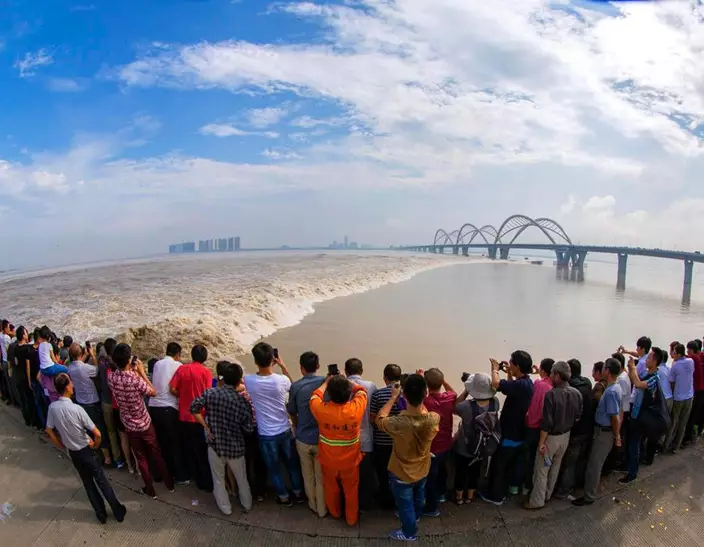
The annual Qiantang River tidal bore, which is expected to be seen this year during the National Day holiday week, attracts tens of thousands of people from home and abroad. (Photo/China Daily)
With the passage of time, however, the best spot to get a view of the tidal bore has now shifted to a section of the seawall in Yanguan township in Haining county.
Now, in the small town of Yanguan, about 40 km away from Hangzhou, the Qiantang River Tide Watching Festival is held annually, attracting tens of thousands of people from home and abroad.
Besides the magnificent tidal bore, people can observe other bores-the one-line bore, the cross bore and the back-flow bore.
Yanguan town, where the grand festival is held, offers the best view of the one-line bore. There, the water runs like a line of troops marching forward at a steady pace amid a thunderous sound.
The cross bore is rare and can be seen clearly only from the Jiaxing-Shaoxing bridge in Hangzhou Bay.
There, the Qiantang River tide divides into two strands to pass the sediment accumulation in the bay area.
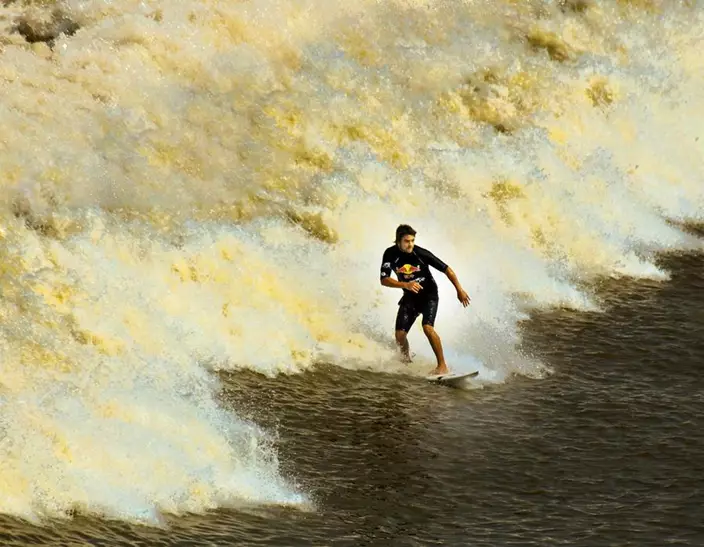
The annual Qiantang River tidal bore, which is expected to be seen this year during the National Day holiday week, attracts tens of thousands of people from home and abroad. (Photo/China Daily)
The back-flow bore is the most popular one with young people where they wait at the river dike.
When the waters come toward them, the cautious ones move away, but many wait until the 5-meter high water wall crashes into the dike.
The back-flow bore can be experienced at Laoyancang in Haining county, in Jiaxing city, as well as in Qige, in Jianggan district and at the Beauty dike, in Xiaoshan district in Hangzhou.
Be sure to arrive at the place of your choice in time, or you may miss the short but breathtaking spectacle that can be seen only once a year.
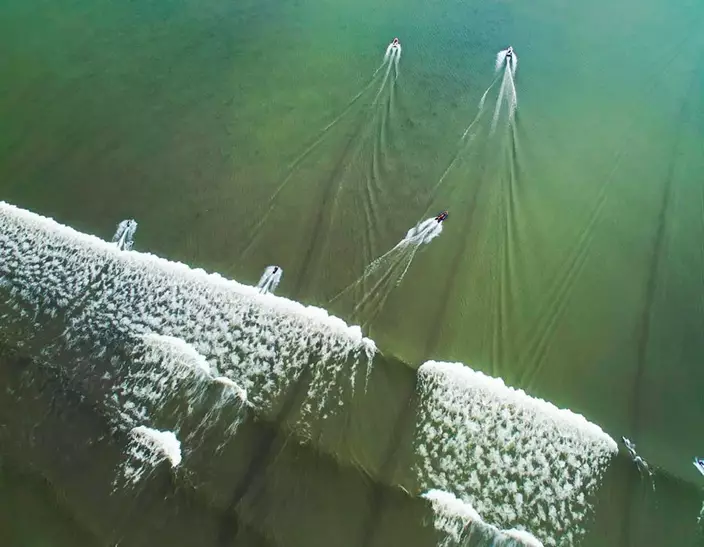
The two tides then come closer and flow together like embracing lovers, offering a magnificent view. (Photo/China Daily)
WEST PALM BEACH, Fla. (AP) — President Donald Trump said he ordered a series of airstrikes on the Houthi-held areas in Yemen on Saturday, promising to use “overwhelming lethal force” until the Iran-backed rebels cease their attacks on shipping along a vital maritime corridor. The Houthis said at least 31 people were killed, and Trump's national security adviser said Sunday that the strikes had successfully targeted “multiple” Houthi leaders.
“Our brave Warfighters are right now carrying out aerial attacks on the terrorists’ bases, leaders, and missile defenses to protect American shipping, air, and naval assets, and to restore Navigational Freedom,” Trump said in a social media post. “No terrorist force will stop American commercial and naval vessels from freely sailing the Waterways of the World.”
He also warned Iran to stop supporting the rebel group, promising to hold the country “fully accountable” for the actions of its proxy. It comes two weeks after the U.S. leader sent a letter to Iranian leaders offering a path to restarting bilateral talks between the countries on Iran’s advancing nuclear program. Trump has said he will not allow it to become operational.
“This was an overwhelming response that actually targeted multiple Houthi leaders and took them out,” Trump national security adviser Michael Waltz said on ABC's “This Week.” that aired Sunday.
The Houthis reported explosions in their territory Saturday evening, in the capital of Sanaa and the northern province of Saada, the rebels’ stronghold on the border with Saudi Arabia, with more airstrikes reported in those areas early Sunday. Images online showed plumes of black smoke over the area of the Sanaa airport complex, which includes a sprawling military facility. The Houthis also reported airstrikes early Sunday on the provinces of Hodeida, Bayda, and Marib.
The Houthi-run Health Ministry said early Sunday that the death toll had climbed to 31, including women and children. Anees al-Asbahi, a spokesperson for the ministry, said Sunday that another 101 people were wounded.
A U.S. official said this was the beginning of air strikes on Houthi targets that are expected to continue. The official spoke on the condition of anonymity because they were not authorized to talk to the press.
Nasruddin Amer, deputy head of the Houthi media office, said the airstrikes won’t deter them and they would retaliate against the U.S. “Sanaa will remain Gaza’s shield and support and will not abandon it no matter the challenges,” he added on social media.
Another spokesman, Mohamed Abdulsalam, on X, called Trump’s claims that the Houthis threaten international shipping routes “false and misleading.”
The airstrikes come a few days after the Houthis said they would resume attacks on Israeli vessels sailing off Yemen in response to Israel’s latest blockade on Gaza. They described the warning as affecting the Red Sea, the Gulf of Aden, the Bab el-Mandeb Strait and the Arabian Sea.
There have been no Houthi attacks reported since then.
Earlier this month, Israel halted all aid coming into Gaza and warned of “additional consequences” for Hamas if their fragile ceasefire in the war isn’t extended as negotiations continue over starting a second phase.
The Houthis had targeted over 100 merchant vessels with missiles and drones, sinking two vessels and killing four sailors, during their campaign targeting military and civilian ships between the start of the war between Israel and Hamas in late 2023 and January of this year, when this ceasefire in Gaza took effect.
The attacks raised the Houthis’ profile as they faced economic and other problems at home amid Yemen’s decade-long stalemated war that’s torn apart the Arab world’s poorest nation.
The Houthi media office said the U.S. strikes hit a residential neighborhood in Sanaa’s northern district of Shouab. Residents said at least four airstrikes rocked the Eastern Geraf neighborhood there, terrifying women and children.
“The explosions were very strong,” said Abdallah al-Alffi. “It was like an earthquake.”
The Eastern Geraf is home to Houthi-held military facilities and a headquarters for the rebels' political bureau, located in a densely populated area.
The Houthis reported fresh strikes on the southwestern Dhamar province late Saturday. They said the strikes hit the outskirts of the provincial capital, also named Dhamar, and the district of Abs.
The United States, Israel and Britain have previously hit Houthi-held areas in Yemen. Israel’s military declined to comment.
However, Saturday's operation was conducted solely by the U.S., according to a U.S. official. It was the first strike on the Yemen-based Houthis under the second Trump administration.
Such broad-based missile strikes against the Houthis were carried out multiple times by the Biden administration in response to frequent attacks by the Houthis against commercial and military vessels in the region.
The USS Harry S. Truman carrier strike group, which includes the carrier, three Navy destroyers and one cruiser, are in the Red Sea and were part of Saturday's mission. The USS Georgia cruise missile submarine has also been operating in the region.
Trump announced the strikes as he spent the day at his Trump International Golf Club in West Palm Beach, Florida.
“These relentless assaults have cost the U.S. and World Economy many BILLIONS of Dollars while, at the same time, putting innocent lives at risk,” Trump said.
Baldor reported from Washington and Magdy reported from Cairo. AP White House Correspondent Zeke Miller and AP writer Tara Copp in Washington contributed to this report.
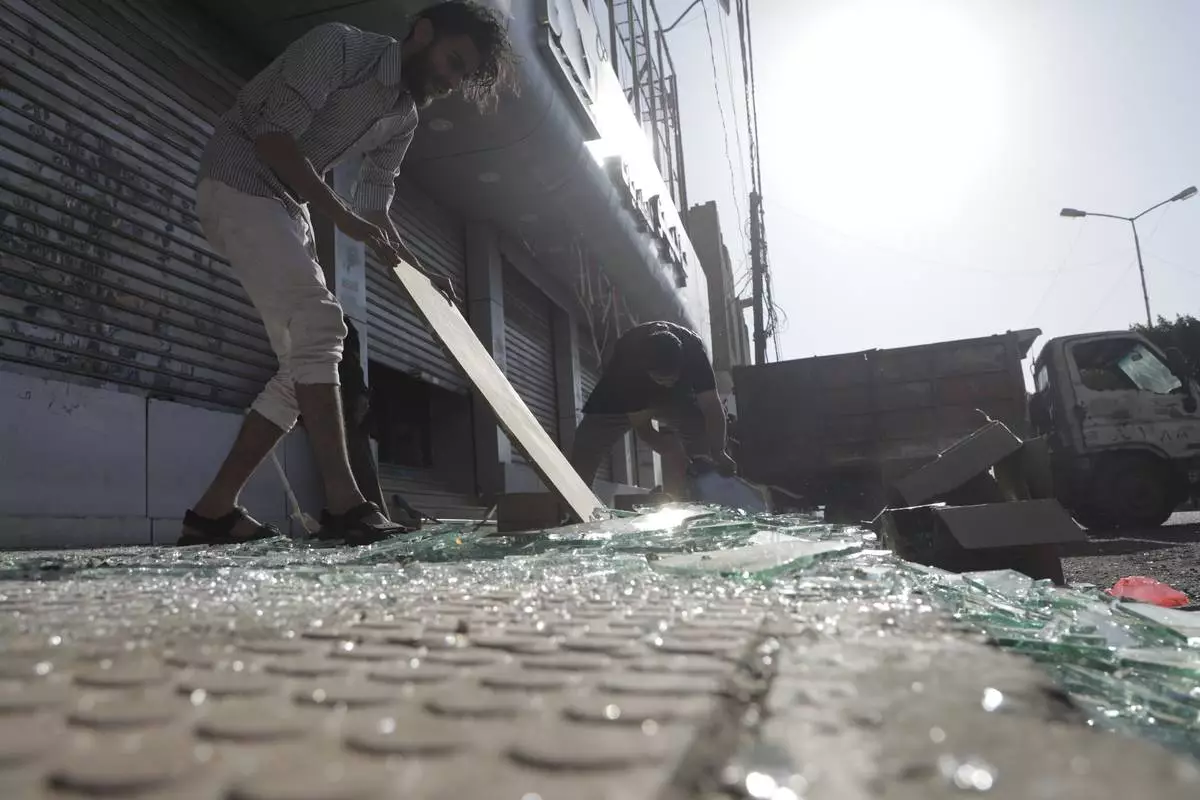
Yemenis clean debris in front of their shops after a U.S. airstrikes in Sanaa, Yemen, Sunday, March 16, 2025. (AP Photo/Osamah Abdulrahman)

Yemenis clean debris in front of their shops after a U.S. airstrikes in Sanaa, Yemen, Sunday, March 16, 2025. (AP Photo/Osamah Abdulrahman)
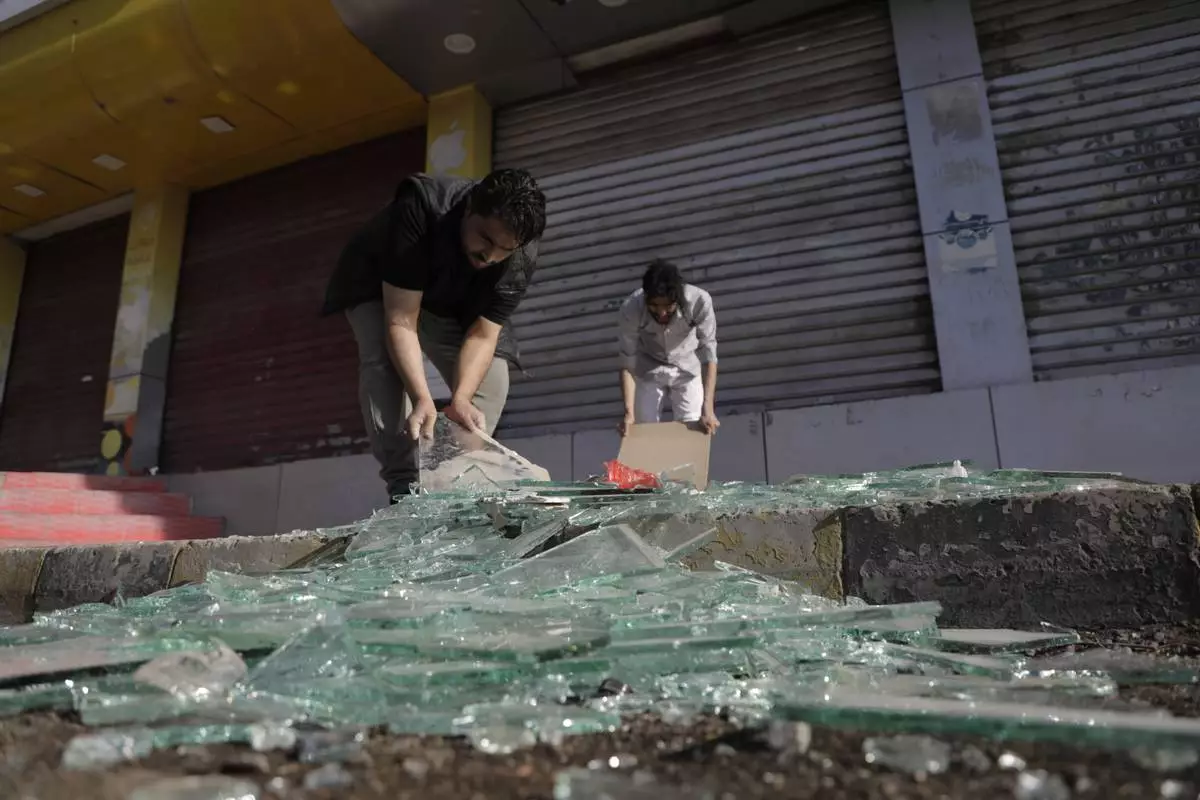
Yemenis clean debris in front of their shops after a U.S. airstrikes in Sanaa, Yemen, Sunday, March 16, 2025. (AP Photo/Osamah Abdulrahman)

This image taken from video provided by the U.S. Navy shows an aircraft launching from a carrier in an undisclosed location before airstrikes in Sanaa, Yemen, Saturday, March 15, 2025. (U.S. Navy via AP)

This image taken from video provided by the U.S. Navy shows an aircraft launching from a carrier in an undisclosed location before airstrikes in Sanaa, Yemen, Saturday, March 15, 2025. (U.S. Navy via AP)
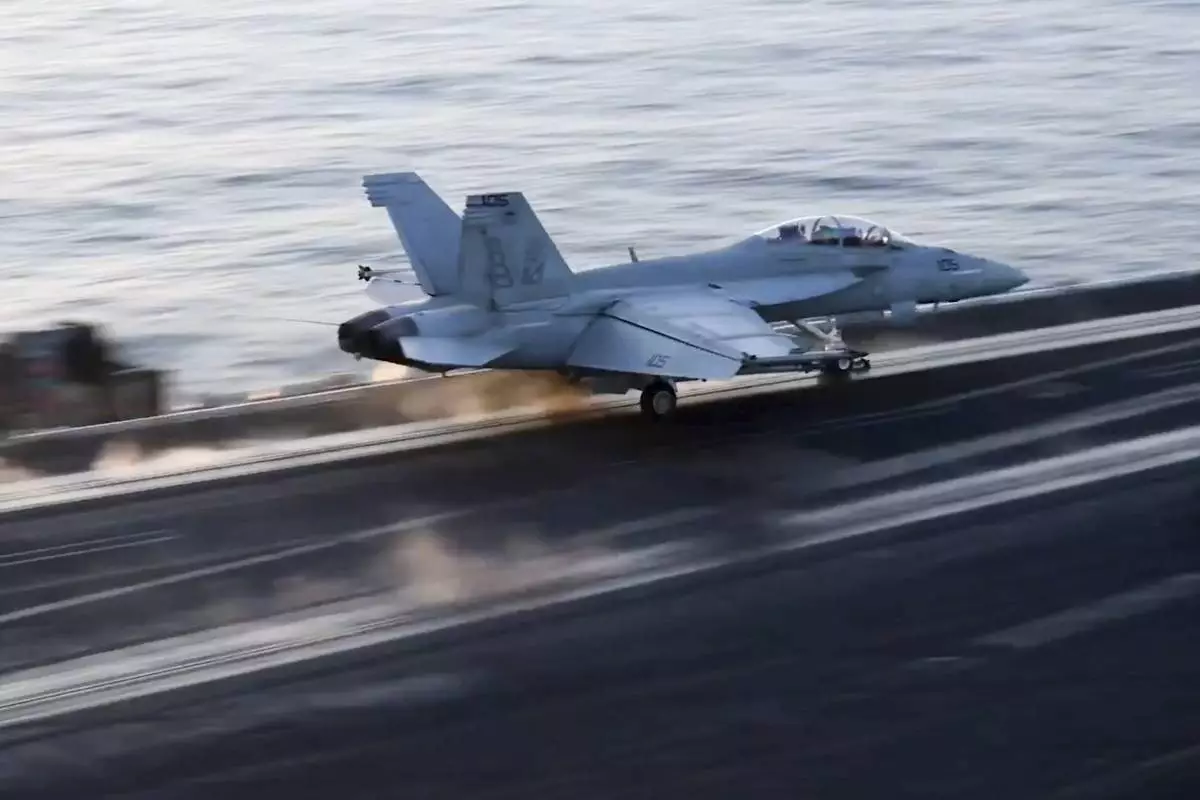
This image taken from video provided by the U.S. Navy shows an aircraft launching from a carrier in an undisclosed location before airstrikes in Sanaa, Yemen, Saturday, March 15, 2025. (U.S. Navy via AP)
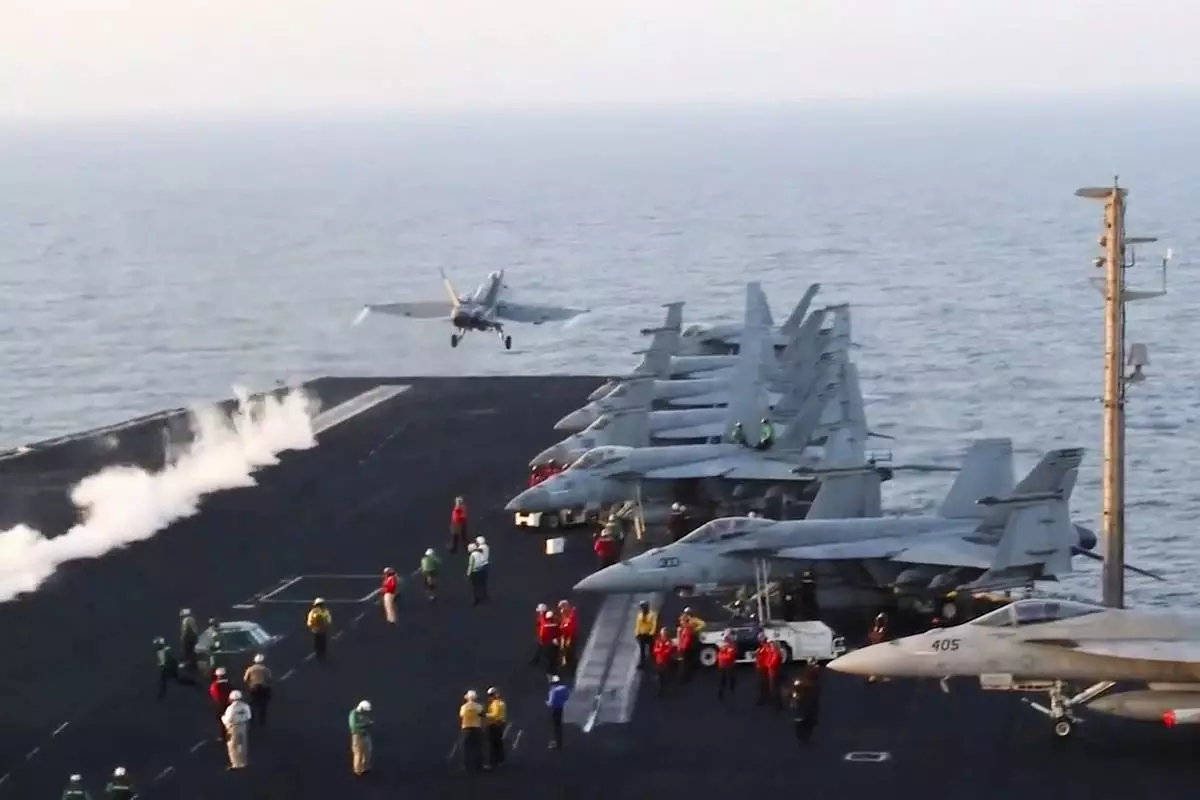
This image taken from video provided by the U.S. Navy shows an aircraft launching from a carrier in an undisclosed location before airstrikes in Sanaa, Yemen, Saturday, March 15, 2025. (U.S. Navy via AP)
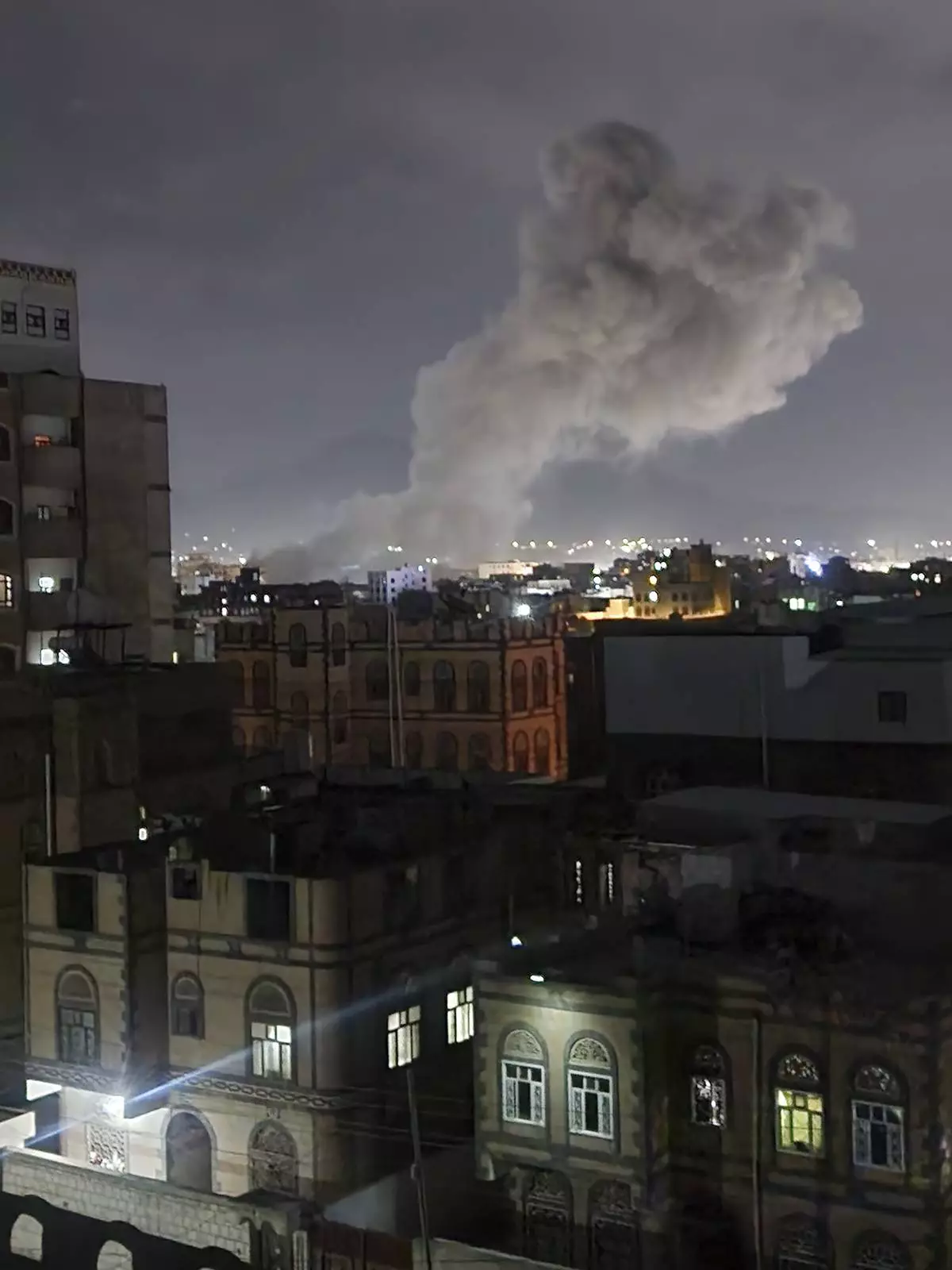
Smoke rises from a location reportedly struck by U.S. airstrikes in Sanaa, Yemen, Saturday, March 15, 2025. (AP Photo/Osamah Abdulrahman)

President Donald Trump addresses a joint session of Congress at the Capitol in Washington, Tuesday, March 4, 2025. (Win McNamee/Pool Photo via AP)
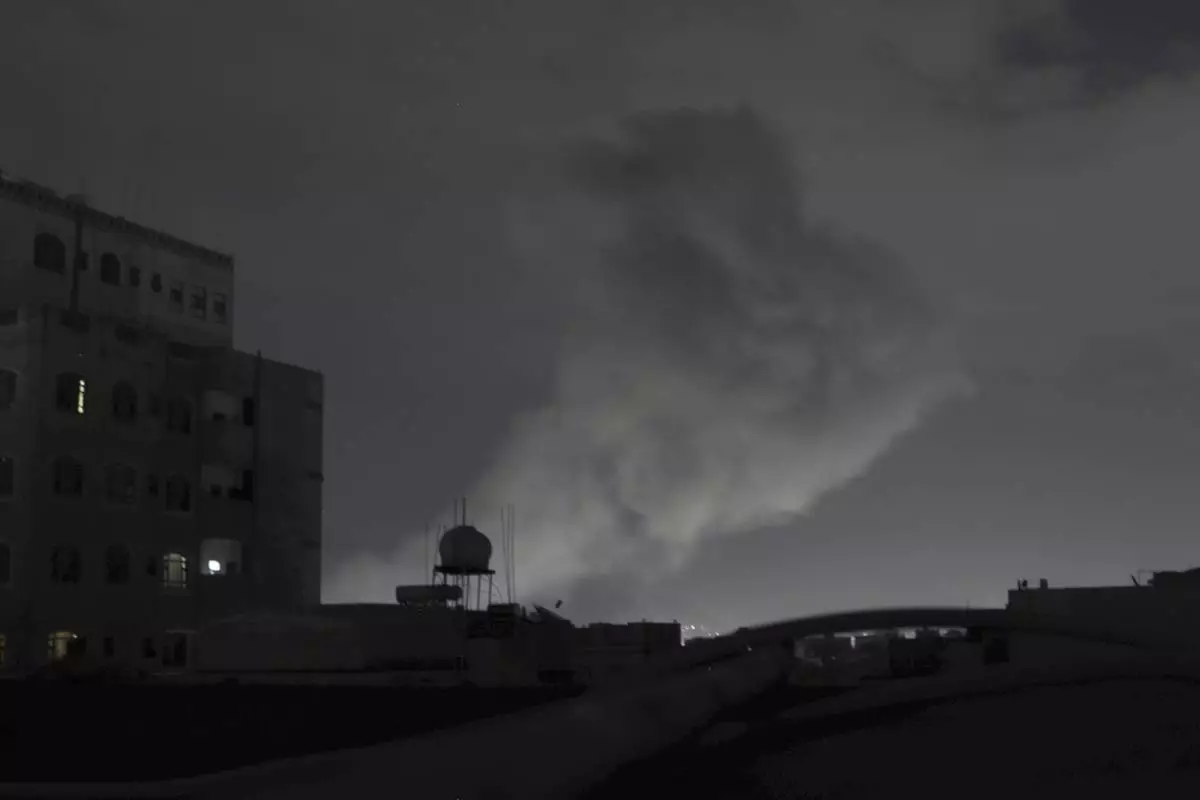
Smoke rises from a location reportedly struck by U.S. airstrikes in Sanaa, Yemen, Saturday, March 15, 2025. (AP Photo/Osamah Abdulrahman



















